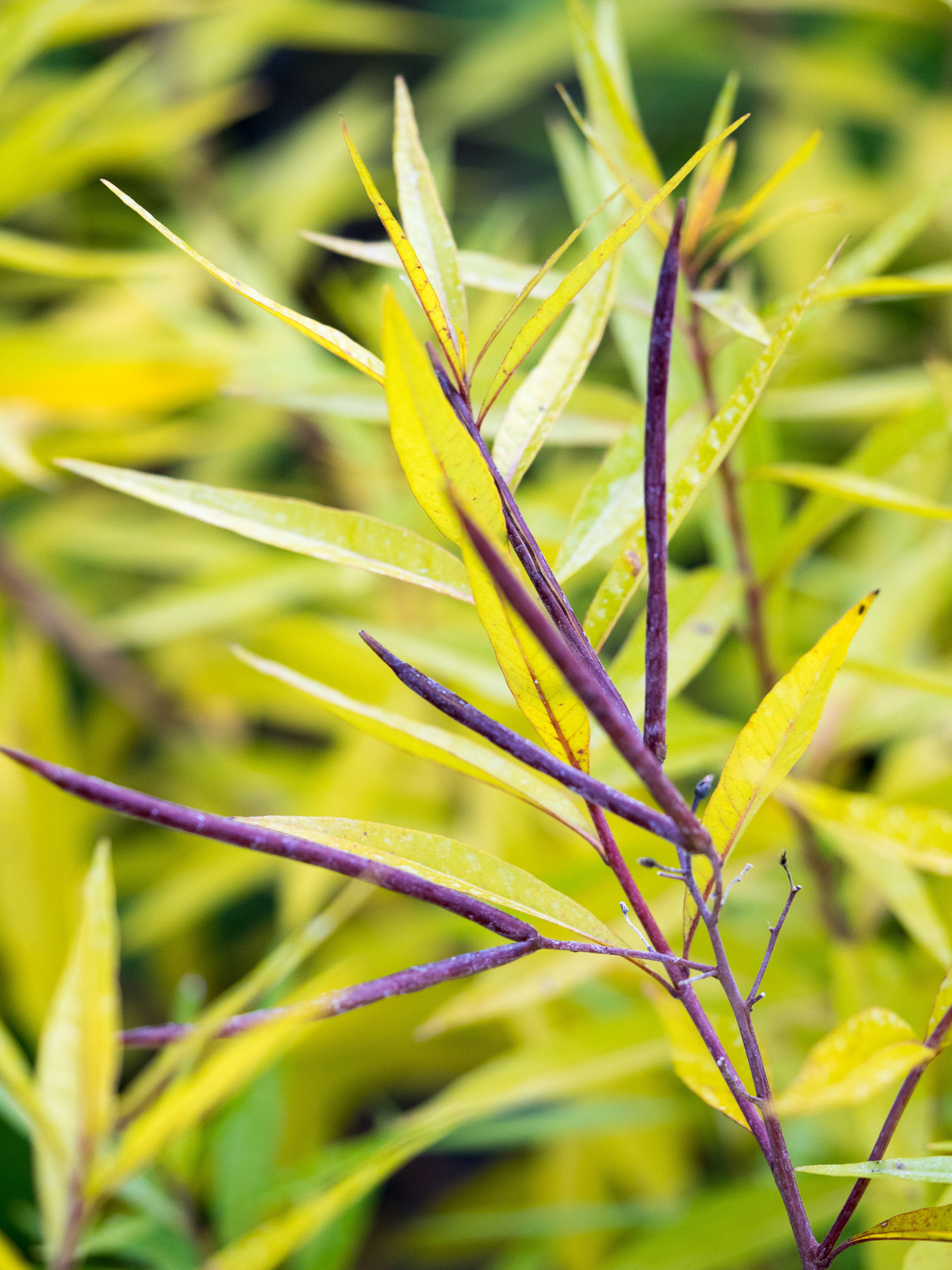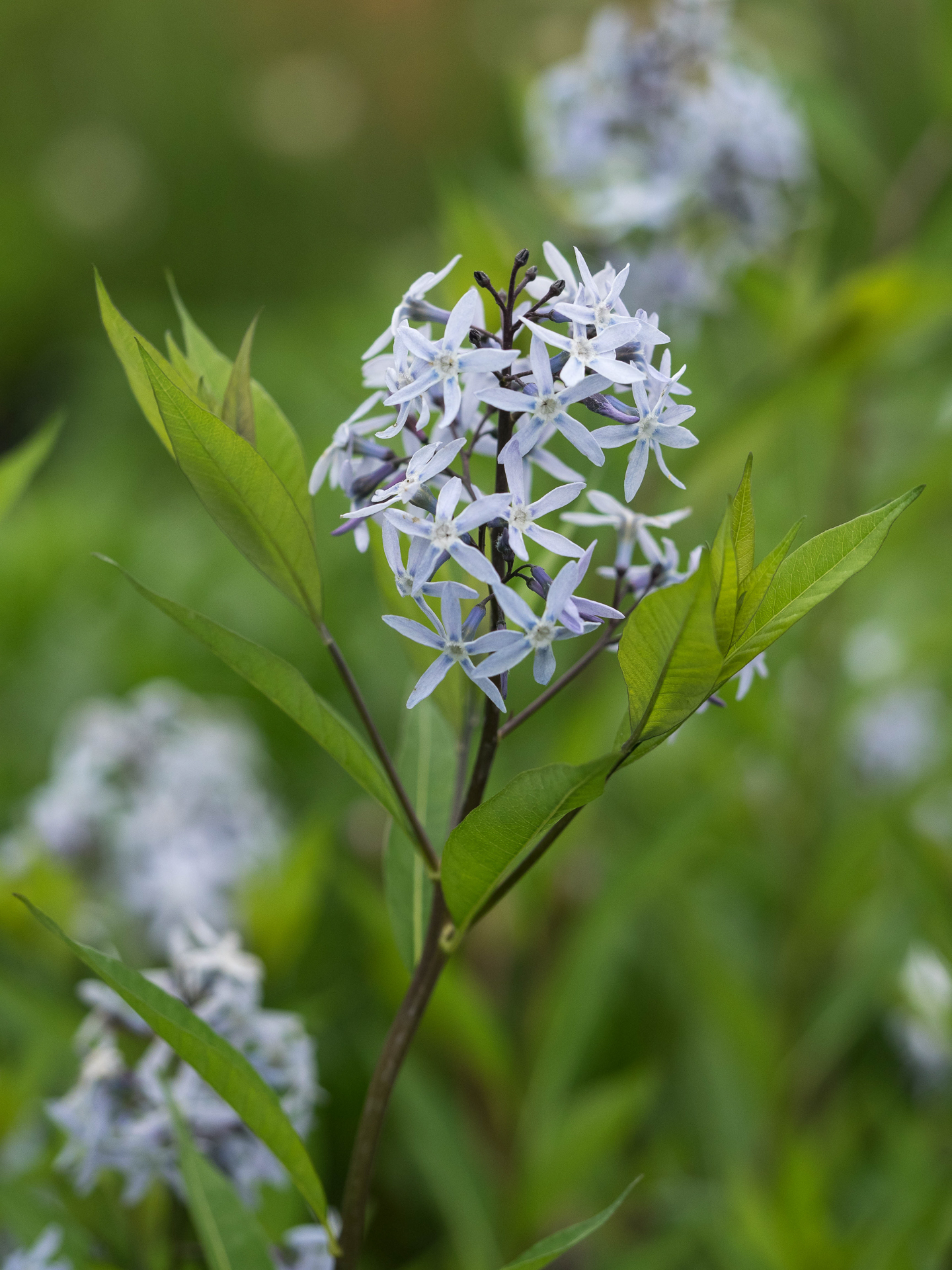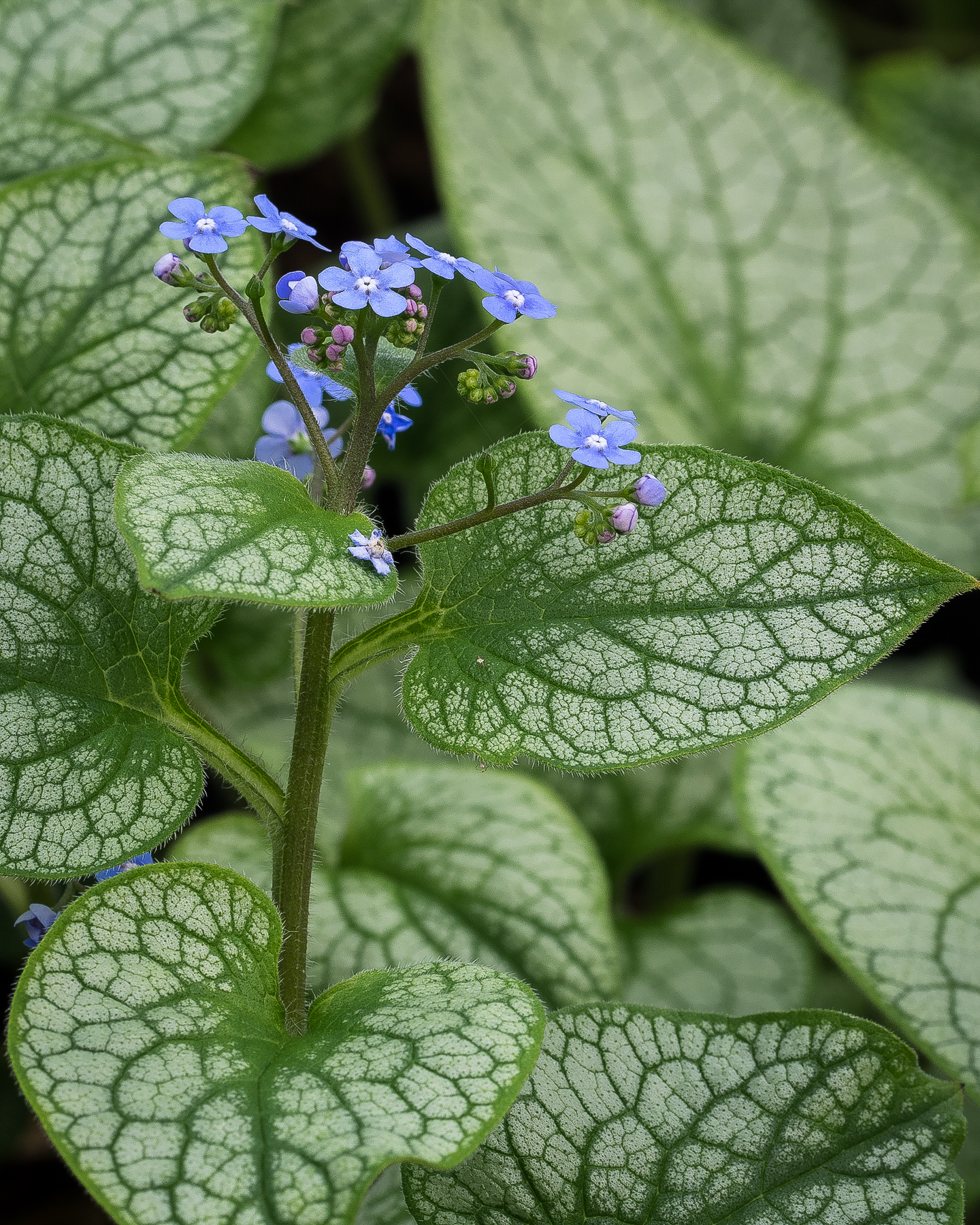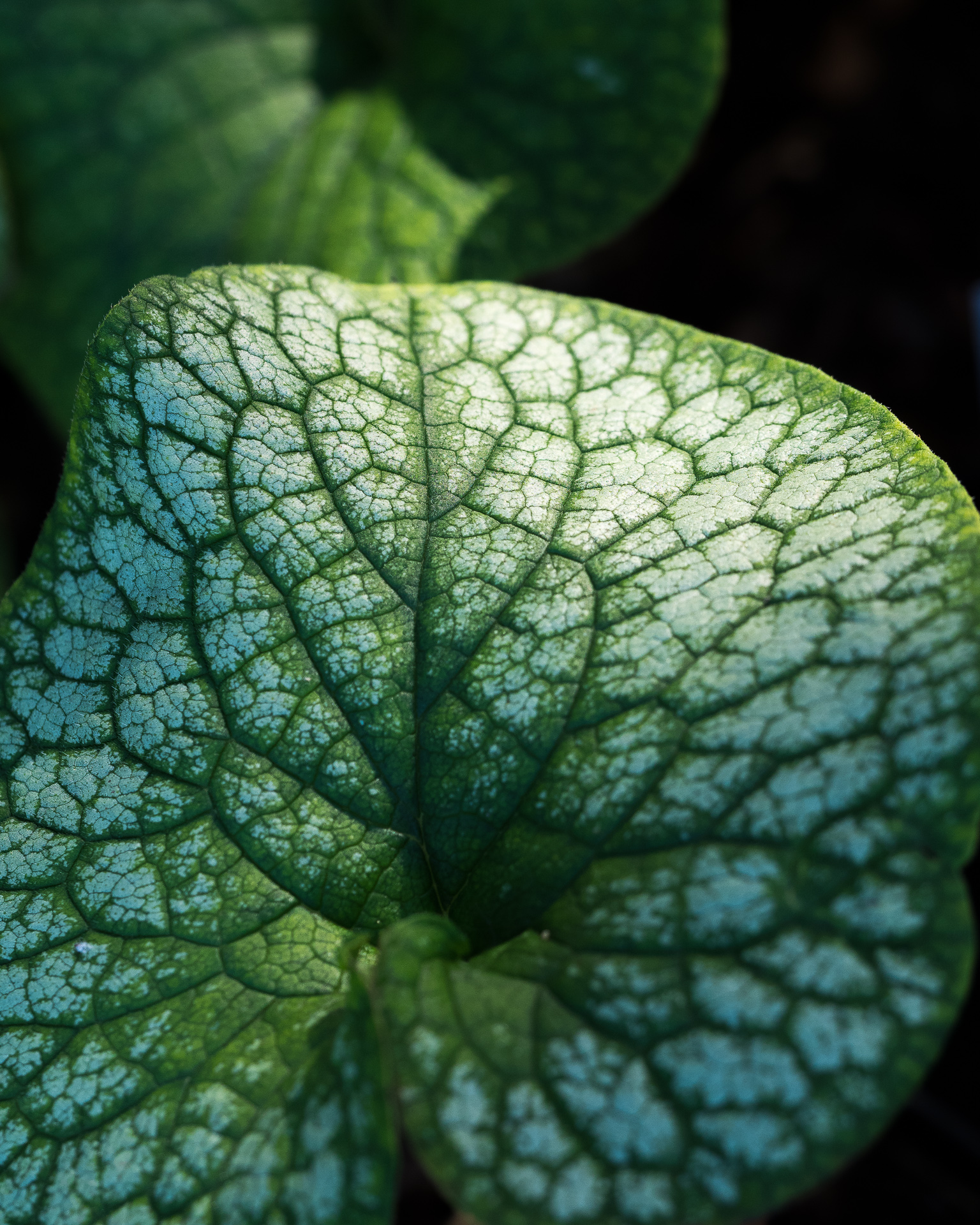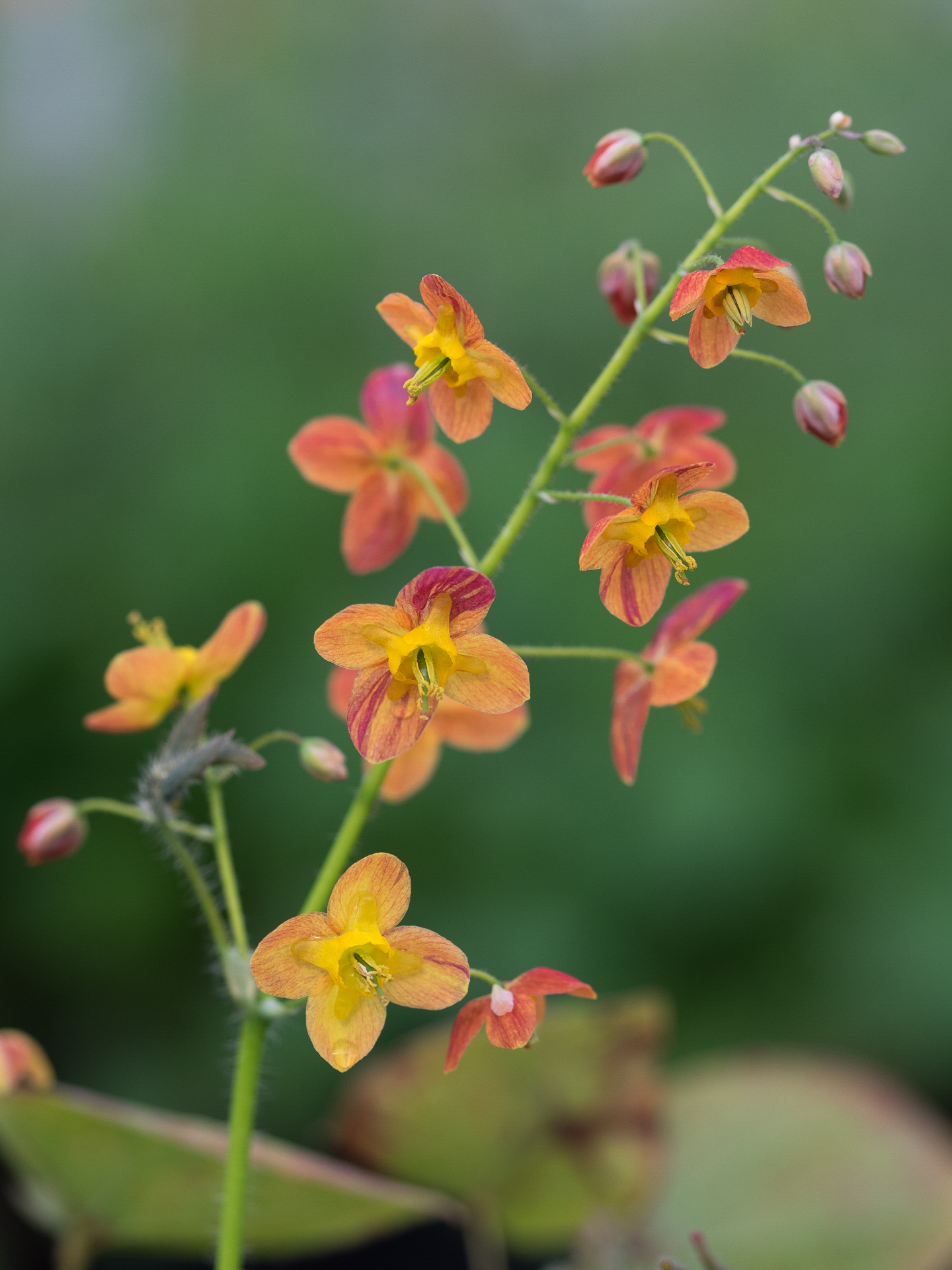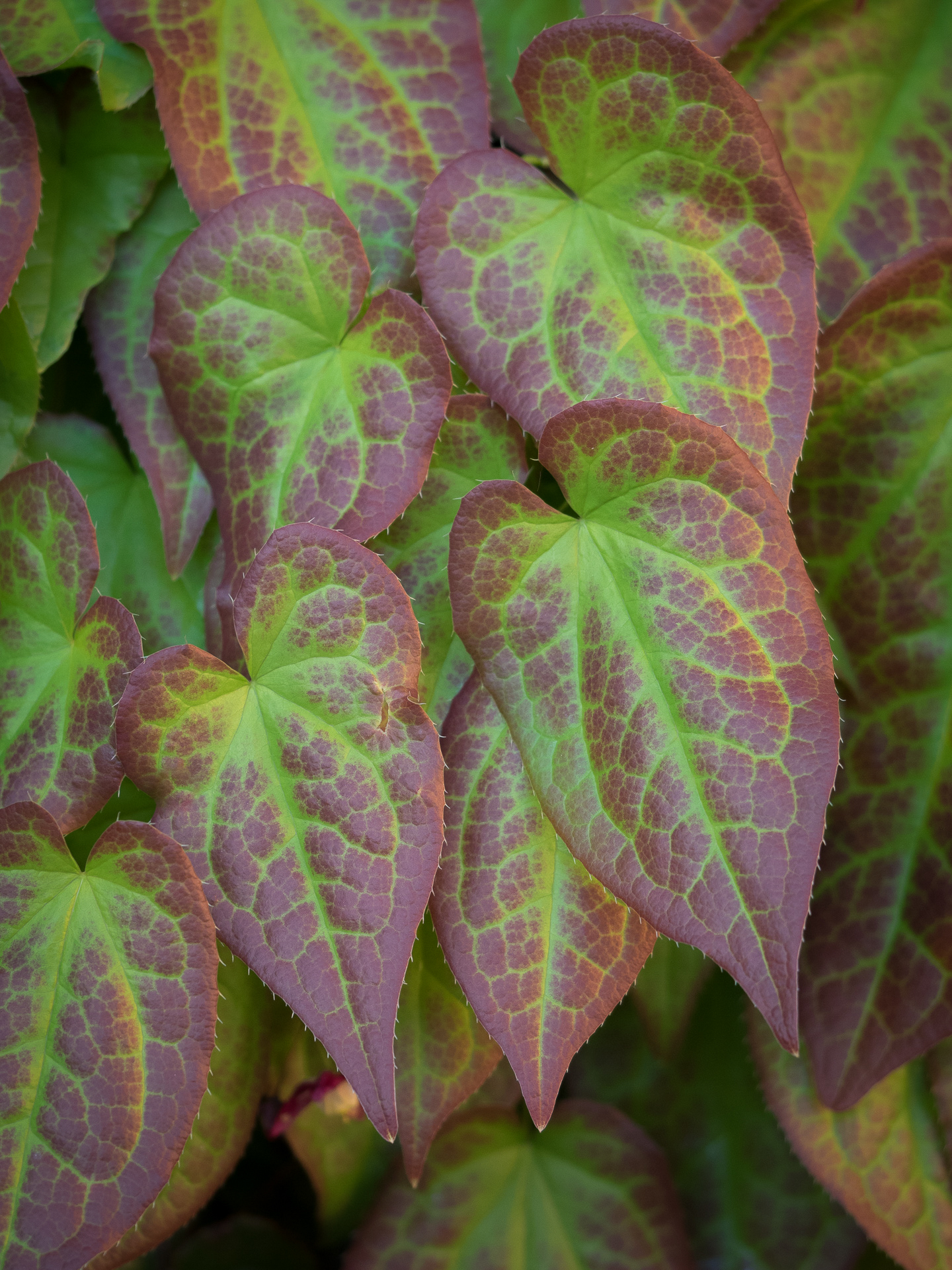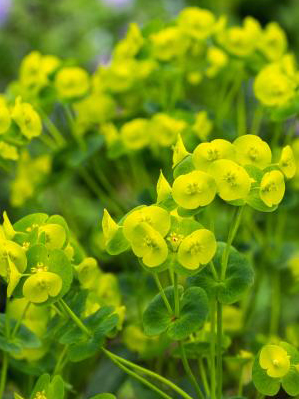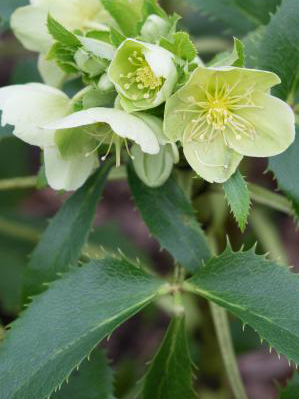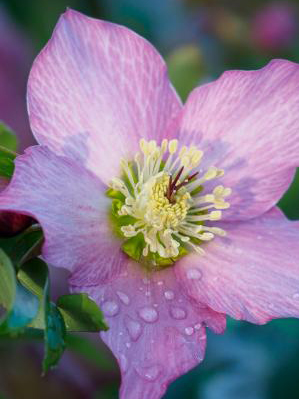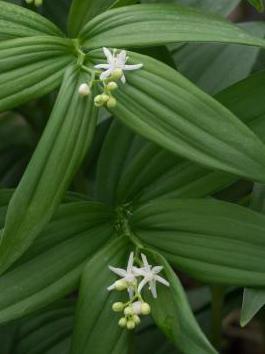Spring flowering plants and fabulous foliage - what more could you want ?
Some spring flowers quite literally leave nothing in their wake, whilst others just keep on giving, providing foliage interest in the garden for weeks, if not months on end. We’ve selected 10 different plant genera which we think are worthy of giving a go especially if you have a small garden where every plant really needs to work hard to earn its place in the border; many of our top 10 would also look great planted in a pot!
AJUGA
- Common name: Bugle
- Soil type: Moisture-retentive, reasonably good soil
- Aspect: Partial shade
- Flowering time: Spring to early summer
AJUGA has a low, creeping habit ideal for providing edging to your border or using as ground cover beneath shrubs or trees.
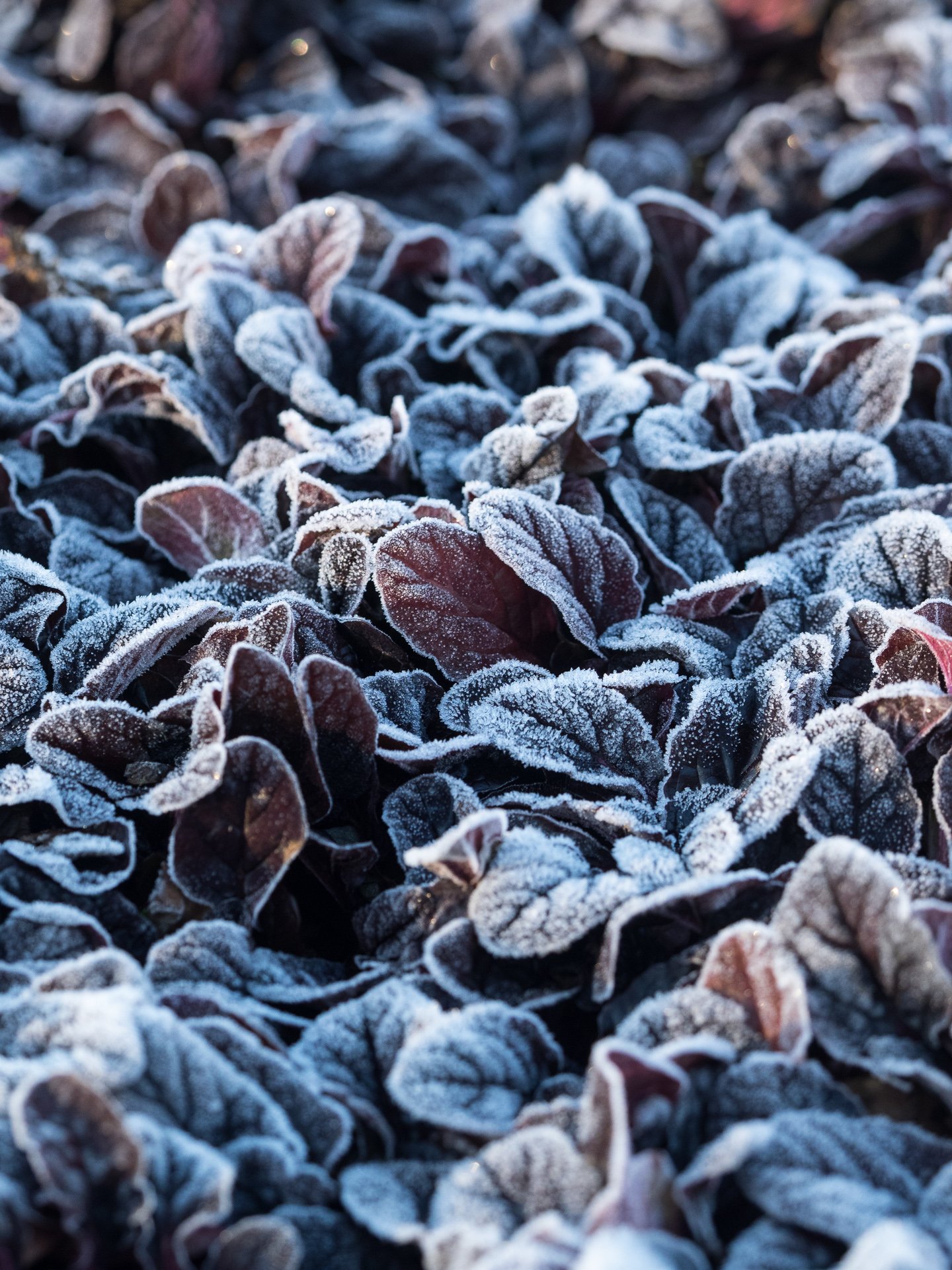
Ajuga reptans 'Braunherz' covered in frost in the depths of winter
One to try …… AJUGA reptans 'Catlin's Giant’ Height x Spread: 30 cm x 60 cm
In late spring big blue flower spikes are held upright above the glossy, metallic purple leaves that hug the ground. This lustrous foliage looks good throughout the rest of the year. Combine them with the contrasting foliage of Epimedium and/or Lamium maculatum in a planter. Easy to grow, it will happily sprawl, but a quick trim will keep it in check. It prefers soil with a good organic content and a semi-shady position.
AJUGA reptans 'Catlin's Giant’
AMSONIA
- Common name: Blue star.
- Soil type: Moisture-retentive, free-draining sandy soil
- Aspect: Partial shade to full sun
- Flowering time: Late spring to early summer.
AMSONIA can be a great asset to a partially shaded area of the garden, its naturalistic form looks wonderful planted en masse within open woodland schemes or drifting through informal cottage gardens . Deer tend to dislike its taste too. Easy to grow, it prefers a reasonable, moist but well-drained soil in partial shade, it will tolerate a sunnier site.
AMSONIA illustris displaying its autumnal foliage
One to try …… AMSONIA ciliata Height x Spread: 80 cm x 45cm
From late spring to early summer beautiful pale blue starry flowers are held in clusters on slender stems. An added bonus is its wonderful, golden yellow autumnal foliage, which sings out as other colours in the garden start to fade.
BRUNNERA
- Common name: Siberian bugloss
- Soil type: Moisture-retentive, free-draining
- Aspect: Partial shade to sun
- Flowering time: Late spring to early summer
BRUNNERA are striking perennials for the front of the border or for providing bright and beautiful ground cover within shady areas of the garden. In recent years many new Brunnera varieties have been developed with foliage ranging from green with cream edges through to almost entirely silver. Plant in any reasonably good soil, in either full or dappled shade.
BRUNNERA macrophylla 'Alexanders Great’
One to try …… BRUNNERA macrophylla 'Alexanders Great’ Height x Spread: 40cm x 90cm
'Alexander's Great' produces a sensational large mound of heart-shaped leaves. The foliage is silver with deep green veining. In spring petite bright blue forget-me-not like flowers contrast delightfully with the foliage. If you are short on border space this Brunnera would look equally stunning in a large pot or planter.
Just one of BRUNNERA macrophylla 'Alexanders Great’s magnificent heart shaped leaves
EPIMEDIUM
- Common name: Barrenwort
- Soil type: Moist but well-drained
- Aspect: Partial shade - sun
- Flowering time: Spring
EPIMEDIUM can be planted as ground-cover beneath the overhanging branches of trees or shrubs. Evergreen forms of Epimedium should ideally have their old winter foliage cut off before the new growth emerges in the spring; this will allow the exquisite, dainty flowers to rise above the fresh young foliage.
EPIMEDIUM x warleyense 'Orangekonigin'
One to try …… EPIMEDIUM x rubrum Height x Spread: 30cm x 60cm
An older garden variety of Epimedium that is still really worthwhile growing, it is a great plant for shady borders and it's easy to grow. The pretty pink and white flowers are held above the fresh green spring foliage. As it is evergreen, in the winter months the foliage is still a feature. In the spring it is best to cut off the winter foliage to allow the new flower and foliage shoots to emerge easily.
EUPHORBIA
- Common name: Spurge
- Soil type: most species can thrive in a reasonable soil whilst some can cope with drier soils and some with more moisture
- Aspect: varies with the species from sun through to shade
- Flowering time: mostly spring and summer
EUPHORBIA can be a bit of a 'marmite' genus, with some disliking its vivid lime flowers but many of its species make good garden plants, valued for their all year round interest and ability to provide structure in a garden, especially over winter. Its foliage varies with species too, from almost lush and tropical to feathery, there is usually a Euphorbia to suit most situations. Just beware of its harmful sap and wear protective gloves when handling it.
EUPHORBIA x martini 'Ascot Rainbow'
One to try …… EUPHORBIA amygdaloides var. robbiae Height x Spread: 60cm x 60cm
Commonly known as 'Mrs Robb's bonnet' after the famous plant collector Mary Ann Robb who found it in Turkey and brought seeds and cuttings back to Hampshire in a hatbox, this EUPHORBIA is easy to grow and low maintenance. Able to cope with most soils and light conditions from full sun to deep shade, the large clusters of lime flowers or more accurately bracts are the perfect counterpoint for many spring bulbs, with its lush evergreen foliage providing year round interest and structure.
EUPHORBIA amygdaloides var. robbiae
HELLEBORUS
- Common name: Hellebores
- Soil type: humus-rich, moist soil but with some drainage so that it is not overly so, non-acidic soil
- Aspect: varies with the species, most prefer part shade but some such as H. sternii and H. argutifolius can cope with sunnier conditions
- Flowering time: late winter into spring
HELLEBORUS species are rightly lauded for their ability to deliver grace and colour in the coldest, greyest time of the year, but their foliage should not be overlooked. Their lush, green architectural leaves not only act as a foil to show off other flowers during the year but provide useful structure in the garden when other plants are looking less than their best.
H. argutifolius justifying its common name 'holly leaved hellebore'
One to try ..... HELLEBORUS 'Walberton's Rosemary' Height x Spread: 35cm x 60cm
This recently introduced hybrid cross of H. niger and H. x hybridus is rather special, producing masses of dusty pink flowers that face outwards unlike many Hellebores. Long flowering from December into March, they are a great value choice for a small garden or where you want loads of impact in the winter. Perfect too for a winter planter, mixed with OPHIOPOGON planiscapus 'Black Beard' or AJUGA.
HELLEBORUS 'Walberton's Rosemary'
MAIANTHEMUM
- Common name: 'False Soloman's seal'
- Soil type: Fertile, humus-rich, moist soil but not overly so
- Aspect: Part shade to shade
- Flowering time: Spring
MAIANTHEMUM are very useful plants for the shady spring garden. Their foliage clumps up well with strong stems holding leathery green leaves with a resemblance to 'Soloman's Seal', but at the end of each stem starry white flowers are produced with a delicious fragrance. Good foliage and scent combo' - what's not to like? Once the flowers fade you can deadhead them and the foliage remains upright acting as a lush foil for other border plants through the summer.
One to try ..... MAIANTHEMUM paniculatum Height x Spread: 50cm x 50cm
Deliciously scented in spring with small creamy-white star-like flowers, M. paniculatum is also a visual treat for the shady garden with glossy spear-shaped foliage. Cream coloured fruits follow the flowers adding further interest through the summer into late autumn, when the foliage finally flags. Its size, naturalistic habit and preferred conditions make it a strong candidate for a woodland themed garden but it is useful for underplanting bare-legged shrubs.
MAINATHEMUM paniculatum as part of Rosy' RHS Chelsea Flower Show Garden 2016
PULMONARIA
- Common name: Lungwort
- Soil type: Fertile, humus-rich, moist soil but not overly so
- Aspect: Part shade to shade
- Flowering time: Late winter and early spring
PULMONARIA is recognised as a true stalwart of the spring garden, delivering colour and often striking foliage from the grey days of late winter into early spring. Short in height, species tend to clump up well to form highly successful groundcover suppressing those pesky weeds. Highly adaptable they suit a variety of planting styles from wildlife to coastal gardens, walled courtyards to slopes.
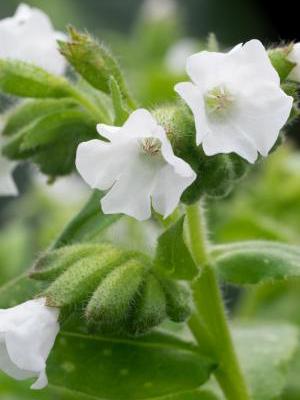
PULMONARIA 'Ice Ballet' (Classic Series)
One to try ..... PULMONARIA 'Diana Clare' Height x Spread: 40cm x 30cm
Much admired for its silvery-green foliage with delicate dark green speckles 'Diana Clare' is so useful for brightening up a shady spot. But from late winter into early spring, loose clusters of large violet flowers appear, gently nodding in the breeze. Once these have faded further fresh leaves can be encouraged by cutting the faded foliage back hard to the ground.
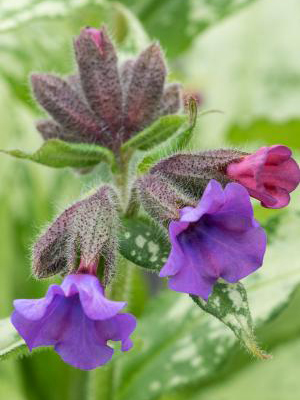
SAXIFRAGA
- Origin of name: Latin for 'Stone-breaker'
- Soil type: majority of species grow in fairly fertile, reasonably moist but well-drained soil
- Aspect: Sun to occasionally part shade
- Flowering time: Late winter and early spring
SAXIFRAGA deserves to be better known as a genus. Yes they are compact and appear unassuming but they have a surprise up their sleeves. Their foliage is fascinating, almost mesmeric, with overlapping rosettes of waxy leaves all year round but then they flower and boy do they go for it, producing masses of small often bright coloured flowers, transforming the plant.
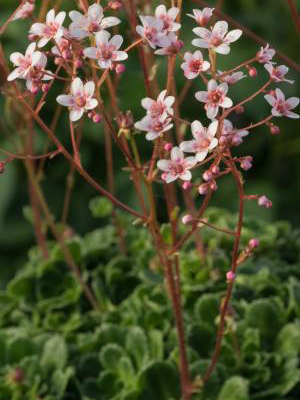
SAXIFRAGA 'Winifred Bevington' with basal rosettes of waxy leaves and starry flowers
One to try ..... SAXIFRAGA 'Vaccariana' (oppositifolia) Height x Spread: 5cm x 20cm
This ankle-high gem has exquisite year round foliage with dark green, waxy rosettes but come the spring small, vivid purplish-red flowers erupt from deeper hued buds catching the eye. An obvious choice for an alpine trough where it will stealthily creep across the surface, it also works well in a rock or gravel garden, especially one that can offer part shade as its roots prefer to be cool and slightly moist.
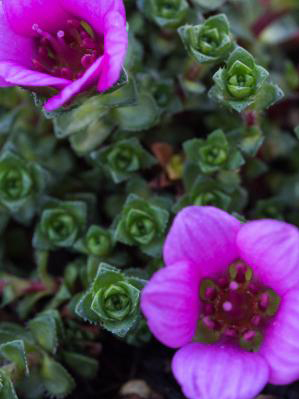
SAXIFRAGA 'Vaccariana' (oppositifolia)
TIARELLA
- Common name: Heart-leaved Foamflower
- Soil type: Cool, moisture-retentive, humus-rich soil.
- Aspect: Partial to deeper shade
- Flowering time: Late spring and early summer.
TIARELLA is a fantastic groundcover for a woodland themed garden or for underplanting shrubs. Its attractive foliage is deeply cut and rather Heuchera-like with eye-catching markings. It looks good deep into early autumn, long after the summer flowers have faded. A good candidate for a mixed planter facing north or east, its delicate flowers will shine out of the shade.
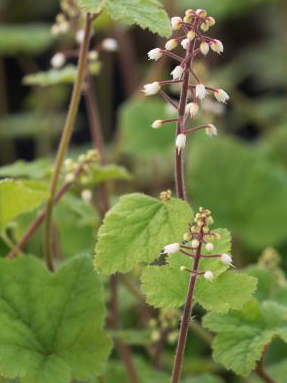
TIARELLA polyphylla 'Filigran'
One to try …… TIARELLA 'Pink Skyrocket' Height x Spread: 30cm x 30cm
One of our favourite 'go-to' plants at the nursery for lifting a gloomy spot in the garden or providing long term interest in a 'shady' planter. Its light and airy flowers are a delicate shade of pink, with the display often lasting from May through to August if the faded flowers are removed regularly. Just gently pull them at their base. The leaves resemble those of Heuchera, fresh green with a distinctive purple central blotch.



